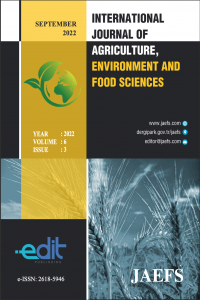Öz
Kaynakça
- Baş, R, & Selmi E. (1990). Important Lymantriidae (Lep.) Species that Damage Turkish Forests, Journal of Istanbul University Faculty of Forestry, Series B, Vol. 40, Issue 2.
- Bulut H. (1991). Studies on Egg Parasitoids, Locations and Natural Activities of Golden Butterfly (Euproctis chrysorrhoea L.). Turkish Journal of Entomology 15(1): 15-24. Retrieved from https://www.acarindex.com/pdfs/125442
- Bilgener, M. (2009). Effects of Nutrient Quality on the Growth and Development of Euproctis chrysorrhoea L. (Lepidoptera: Lymantriidae) Larvae, Biological Sciences Research Journal 2 (2): 69-73.
- Çanakçıoğlu, H. (1983). Forest Entomology. Special Section. Istanbul University Faculty of Forestry Publications, IU Publication No: 3152 O.F. Publication No: 349 Istanbul VIII; 536. Retrieved from https://dergipark.org.tr/tr/download/article-file/176341
- Frago, E., Pujade-Villar, J., G., Miguel and Selfa, J. (2011). Providing insights into browntail moth local outbreaks by combining life table data and semi-parametric statistics , Ecological Entomology, 36(2), 188-199. Doi: https://doi.org/10.1111/j.1365-2311.2010.01259.x
- Gürses, A. (1975). Studies on the Bio-Ecology and Warfare of Euproctis chrysorrhoea L. (Lep.:Lymantriidae) in Thrace Region. Zir. Mc. Zir. Prof. Gn. Md., No: 8 Istanbul 79s. Retrieved fromhttps://dergipark.org.tr/tr/download/article-file/174957
- İren, Z. (1977). Important Fruit Pests, Recognition, Damages, Lives and Methods of Struggle. Ministry of Food, Agriculture and Livestock. Zir. Mc. and Zir. Prof. Gn. Md., 36. Ankara 167s. Retrieved from https://dergipark.org.tr/tr/download/article-file/174957
- Kansu, A. (1955). Studies on the Qualities and Short Biology of Some Macrolepidoptera Species That Damage Central Anatolian Fruit Trees. Zir. Vek., Issue:704. Ankara, 203s. Retrieved from https://www.zobodat.at/pdf/Seitz-Schmetterlinge-Erde_2_Supp_1934_en_0001-0368.pdf
- King, G.E. (1998). The Food-Plants of the Browntail Moth Euproctis chrysorrhoea L. (Lep.: Lymantriidae) in East London. Br. J Entomol. Nat. Hist., 11(3/4):153-159. Retrieved from https://agris.fao.org/agris-search/search.do?recordID=GB1999002879
- Pilarska, D., Linde, A., Goertz, D. et al., (2001). First report on the distribution of microsporidian infections of browntail moth (Euproctis chrysorrhoea L.) populations in Bulgaria. Anzeiger für Schädlingskunde/J. Pest Science 74, 37–39. Doi: https://doi.org/10.1046/j.1439-0280.2001.01007.x
- Sekendiz, O.A. (1991). Abies nordmanniana (Stev.) Spach.’nın Doğu Karadeniz Bölümü Ormanlarındaki Zararlı Böcekleri ile Koruma ve Savaş Yöntemleri. OGM Yayınları, Yayın No: 678, Sıra No: 73, 200 s. (in Turkish).
- Southwood, T.R.E. & Henderson, P.A. (2000). Ecological Methods. Third Edition, Blackwell Science, Oxford, U.K
Euproctis chrysorrhoea Linnaeus, 1758 (Lepidoptera: Lymantriidae) biology and determination of damage Yedisu, Bingöl, Türkiye
Öz
Anahtar Kelimeler
Euproctis chrysorrhoea Biology Damage Biological control Yedisu Bingöl.
Kaynakça
- Baş, R, & Selmi E. (1990). Important Lymantriidae (Lep.) Species that Damage Turkish Forests, Journal of Istanbul University Faculty of Forestry, Series B, Vol. 40, Issue 2.
- Bulut H. (1991). Studies on Egg Parasitoids, Locations and Natural Activities of Golden Butterfly (Euproctis chrysorrhoea L.). Turkish Journal of Entomology 15(1): 15-24. Retrieved from https://www.acarindex.com/pdfs/125442
- Bilgener, M. (2009). Effects of Nutrient Quality on the Growth and Development of Euproctis chrysorrhoea L. (Lepidoptera: Lymantriidae) Larvae, Biological Sciences Research Journal 2 (2): 69-73.
- Çanakçıoğlu, H. (1983). Forest Entomology. Special Section. Istanbul University Faculty of Forestry Publications, IU Publication No: 3152 O.F. Publication No: 349 Istanbul VIII; 536. Retrieved from https://dergipark.org.tr/tr/download/article-file/176341
- Frago, E., Pujade-Villar, J., G., Miguel and Selfa, J. (2011). Providing insights into browntail moth local outbreaks by combining life table data and semi-parametric statistics , Ecological Entomology, 36(2), 188-199. Doi: https://doi.org/10.1111/j.1365-2311.2010.01259.x
- Gürses, A. (1975). Studies on the Bio-Ecology and Warfare of Euproctis chrysorrhoea L. (Lep.:Lymantriidae) in Thrace Region. Zir. Mc. Zir. Prof. Gn. Md., No: 8 Istanbul 79s. Retrieved fromhttps://dergipark.org.tr/tr/download/article-file/174957
- İren, Z. (1977). Important Fruit Pests, Recognition, Damages, Lives and Methods of Struggle. Ministry of Food, Agriculture and Livestock. Zir. Mc. and Zir. Prof. Gn. Md., 36. Ankara 167s. Retrieved from https://dergipark.org.tr/tr/download/article-file/174957
- Kansu, A. (1955). Studies on the Qualities and Short Biology of Some Macrolepidoptera Species That Damage Central Anatolian Fruit Trees. Zir. Vek., Issue:704. Ankara, 203s. Retrieved from https://www.zobodat.at/pdf/Seitz-Schmetterlinge-Erde_2_Supp_1934_en_0001-0368.pdf
- King, G.E. (1998). The Food-Plants of the Browntail Moth Euproctis chrysorrhoea L. (Lep.: Lymantriidae) in East London. Br. J Entomol. Nat. Hist., 11(3/4):153-159. Retrieved from https://agris.fao.org/agris-search/search.do?recordID=GB1999002879
- Pilarska, D., Linde, A., Goertz, D. et al., (2001). First report on the distribution of microsporidian infections of browntail moth (Euproctis chrysorrhoea L.) populations in Bulgaria. Anzeiger für Schädlingskunde/J. Pest Science 74, 37–39. Doi: https://doi.org/10.1046/j.1439-0280.2001.01007.x
- Sekendiz, O.A. (1991). Abies nordmanniana (Stev.) Spach.’nın Doğu Karadeniz Bölümü Ormanlarındaki Zararlı Böcekleri ile Koruma ve Savaş Yöntemleri. OGM Yayınları, Yayın No: 678, Sıra No: 73, 200 s. (in Turkish).
- Southwood, T.R.E. & Henderson, P.A. (2000). Ecological Methods. Third Edition, Blackwell Science, Oxford, U.K
Ayrıntılar
| Birincil Dil | İngilizce |
|---|---|
| Konular | Ziraat, Veterinerlik ve Gıda Bilimleri |
| Bölüm | Makaleler |
| Yazarlar | |
| Yayımlanma Tarihi | 23 Eylül 2022 |
| Gönderilme Tarihi | 3 Haziran 2022 |
| Kabul Tarihi | 26 Temmuz 2022 |
| Yayımlandığı Sayı | Yıl 2022 Cilt: 6 Sayı: 3 |
Kaynak Göster
Cited By
The Determination of Harmful Hymenoptera and Lepidoptera Species in Forest Nurseries in the Western Black Sea Region of Türkiye
Kastamonu University Journal of Forestry Faculty
https://doi.org/10.17475/kastorman.1460642
International Journal of Agriculture, Environment and Food Sciences dergisinin içeriği, Creative Commons Alıntı-GayriTicari (CC BY-NC) 4.0 Uluslararası Lisansı ile yayınlanmaktadır. Söz konusu telif, üçüncü tarafların içeriği uygun şekilde atıf vermek koşuluyla, ticari olmayan amaçlarla paylaşımına ve uyarlamasına izin vermektedir. Yazarlar, International Journal of Agriculture, Environment and Food Sciences dergisinde yayınlanmış çalışmalarının telif hakkını elinde tutar.
Web: dergipark.org.tr/jaefs E-mail: editor@jaefs.com WhatsApp: +90 850 309 59 27



